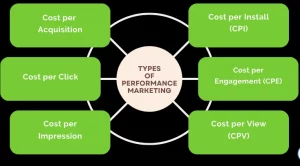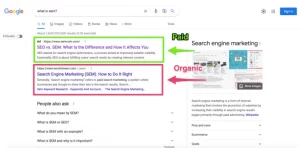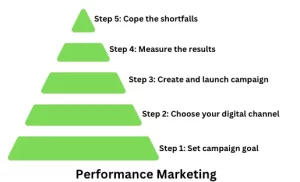Beginner’s Guide to Performance Marketing 2024
Performance marketing is a most effective way to generate desired results. Did you know that PPC returns $2 for every $1 spent -resulting in 200% ROI rate (Study)?
About 65% of small to mid-sized businesses have a PPC campaign. Intrigued by the stats? It is important for the market players to understand that the SEO industry is worth $80 billion. It poses a lot of scope for improvement and the growth projected for year 2023 is $86 billion.
Considering the high relevance of digital advertising and SEO, it is important that not a single effort goes wasted when you talk of business online. And that is where you will have to find more about performance marketing.
Read further to know in-depth.
What is the Performance Marketing Concept?
Performance marketing is a simple term that is used for online marketing campaigns. It is a combination of marketing strategies and digital advertisements to gain qualified leads. And when a lead qualifies, the advertisers make the payment to the publisher. A few other actions for which the advertisers pay could be generating a lead, clicking on a link, making a purchase, and more.

Performance marketing is used to drive actions and measure those actions while contributing to higher ROI. The marketing strategy allows the publishers to monetise their traffic by earning commissions for the actions taken by the users. This makes performance marketing a beneficial model for both advertisers and publishers.
How Performance Marketing Works?
Performance marketing working models include three main parties to include: the publisher, the advertiser, and the customer.
- The advertisers can create offers for products or services. Then the advertiser sets the commission rate for the publishers who refer customers to them.
- The advertisers can create offers for products or services. Then the advertiser sets the commission rate for the publishers who refer customers to them.
- Influencers on social media promote the advertiser’s offer to their audience through websites, blogs, or social media.
- After a customer clicks on the link shared, the publisher or the influencer will earn a commission from the advertiser.
- The advertiser can track the progress of the campaign. And on the other hand, the publisher can track their commission earnings through a performance marketing platform or network.
It brings a win-win situation for both the customers and the advertisers and the publisher gets the commission.
Read: How to Advertise on Instagram?
Types of Performance Marketing
There are several types of performance marketing with its unique characteristics and benefits. Some of the common types of performance marketing include:

Cost-per-Acquisition(CPA):
When the users take any particular action on the platform, the advertiser pays the publisher. This is the most popular form of performance marketing as under it the advertiser pays only when an action is completed.
Cost-per-Click (CPC):
When driving traffic to the website is the only motive, the advertisers pay commission to the publishers. The payment is made for each click on the link or the ad.
Cost-per-Impression (CPI):
Though less common, but under CPI, the advertisers pay commission to the publisher for each impression of their ads. There is no guarantee of any specific action by the user, hence this is a less preferred type of performance marketing strategy.
Cost-per-Install (CPI):
Advertisers pay publishers a commission for each app installation from their referral. Common in mobile app promotion.
Cost-per-Engagement (CPE):
Advertisers pay publishers a commission for each engagement with their ad, such as a like, share, or comment. This type of performance marketing is common in social media advertising.
Cost-per-View (CPV):
Advertisers pay publishers a commission for each video view of their ad. This type of performance marketing is common in video advertising.
Top Performance Marketing Channels
There are several performance marketing channels that an advertiser can use. In performance marketing advertisers pay for clicks or impressions.
Social media advertising:
Some of the platforms provide targeted advertising options which makes driving website traffic easy. Using platforms like Facebook, Instagram, Twitter and LinkedIn brands can drive website traffic, increase brand awareness, and generate leads and sales. Use these to promote content and engage with customers.

- Social media advertising benefits the businesses to reach a large and highly targeted audience at a relatively low cost. Businesses can reach their desired audience easily.
- Advertisers on social media can choose between several ad formats, like sponsored posts, sponsored stories, sponsored events, sponsored video, etc.
- Advertisers have the freedom to choose and pay for their ads on a cost-per-click (CPC) or cost-per-impression (CPM) basis. Advertisers can target their audience based on demographics, interests, behaviors, and location. Some performance metrics advertisers can track include:
-
-
- Impressions
- Likes
- Comments
- Shares
- Clicks
- Sales
- Checkouts
- Completed contact forms
-
- Search Engine Marketing (SEM):
- It is about paid advertising on search engines like Google and Bing. SEM combines native advertising through sponsored search results with other forms of marketing.

- This type of marketing includes promotion of websites by increasing their visibility in search engines through paid advertising.
- SEM includes use of paid search ads to target specific keywords and phrases that are relevant to business or brands. The ultimate goal of SEM is to drive more traffic to the website and build conversions by making it more visible on search results.
Affiliate network:
-
- Affiliate network is a platform that acts as a middle man between the publisher and advertisers. Advertisers establish their programs on affiliate networks and publishers search programs they want to promote.
- Publishers need to apply for the programs they are interested to endorse. After the acceptance, the publishers can have a choice of promotional texts which can be used across different platforms such as social media or websites.
- Affiliate network allows to have:
- Affiliate network is a platform that acts as a middle man between the publisher and advertisers. Advertisers establish their programs on affiliate networks and publishers search programs they want to promote.
-
-
- Effective use of advertising budget
- Product promotion by approved publishers
- Sales track in one place
- Compliance monitoring as a part of service
- Improved ROI
- Increase brand awareness
-
Display Advertising:
-
- Businesses pay commission for clicks or conversions generated through display ads on websites or mobile apps. These days the campaigns are run through programmatic media buying to drive results.

- By choosing specific publishers to place banners ads, you can benefit from contextual targeting. Publishers gather a wealth of data to place targeted ads for their audience.
- The programmatic display advertising helps advertisers to access the same audience throughout the web.
Influencer Marketing:
-
- Influencer marketing allows brands to attract more audience and enable brands to scale up by getting more visibility for higher ROI than expected in any other marketing channel. Influencer marketing is said to boost SEO, ROI and bottom line.

- About 86% marketers use influencer marketing to empower their marketing campaigns. Influencers have large fan followings on Tik Tok, Instagram, Facebook, YouTube, or Twitter.
- Influencer marketing can take any form such as sponsored ads, product reviews, etc. The point is that the fans trust these influencers and these can be a great way for higher sales. The form of marketing can increase reach for specific target audience, drive sales, and increase brand awareness.
- Influencer marketing keeps the advertisement cost low for the business. It makes it cost-effective in comparison to that of paid advertising. The marketing strategy shortens the promotion time and yields results in less time than expected.
- Some insights of influencer marketing are:
-
-
- Branding and engagement focused influencer marketing activities include 8 times more ROI than campaigns.
- 50% marketers state that influencer marketing ROI is higher than any other marketing platform.
- Researches show that about $1 spent on spreading a marketing message via influencer companies earn $18.
-
Facebook Advertising:
-
- Facebook is the most popular social media with approximately 3 billion monthly active users. And 67% of Facebook users are daily users.The figure shows that it is far to look past Facebook’s reach.

- Facebook helps marketers use detailed information and reach the right people with the right product. Because of this ability to draw specific target groups, Facebook draws 10 million active advertisers and earns Facebook $28.6 billion per quarter.
- For Facebook advertising, businesses that do not get too salesy and keep their pitch for simple conversions like signing up for service, filling out lead form or just leaving an email address can get successful conversions.
- Facebook ads have several varieties to promote pages, posts on your page, or website.
- Facebook ads are targeted to users based on their profile, location, and demographics.
- Facebook allows the best ROI using detailed interest targeting.
- Facebook allows brands to retarget the consumers with ads
CPE Ads
Cost per engagement (CPE) ads are online advertising where advertisers only pay when a user takes a specific action, such as clicking on an ad, watching a video, or filling out a form.

-
- CPE ads can be a good option for businesses that want to get more out of their advertising budget by only paying for meaningful interactions. However, it’s important to note that CPE ads can be more expensive than other pricing models, such as CPM (cost per thousand impressions) or CPC (cost per click), as they require more engagement from the user.
- Additionally, it’s important to track the performance of CPE campaigns and optimize them to ensure that the ad is performing well and generating the desired engagement.
- CPE Ads can be used in different campaigns such as social media campaigns, mobile apps, and video ads.
- Cost per engagement improves flexibility and creativity that helps advertisers remain tuned to market trends.
- Every social media engagement or interaction raises brand awareness.
- CPE guarantees that the marketing team and advertisers do not waste their budget on useless ads. Companies often pay for ads that engage audiences.
CPL Ads
-
- Cost per Lead is a model in which the advertisers pay a fee for each lead that is generated by an ad. A lead is defined as a potential customer who has expressed interest in a product or services.
- Advertisers pay a pre-established price for each lead generated.

-
- A higher CPL for you means higher quality leads and low customer acquisition costs.
- To keep the acquisition cost low and business performance high, the advertisers must know to identify the target audience accurately and focus on generating relevant content. Advertisers must spend time and money on high performing keywords. Retarget the existing customers and perform A/B tests.
- CPL advertising is used in B2B marketing where the intent is to generate leads that can be converted into sales.
Sponsored Content
-
- In the field of marketing everything goes fair until you are fetching return on your investment. And in marketing content plays a major role. Using sponsored content helps the brands reach a specific target audience and build trust.

- Sponsored content is an ad where brands pay to have their product or service featured on social media, websites, or other digital platforms. The content is created by the brand and designed to look like regular editorial content.
- Sponsored content can help increase brand awareness and take it to a wider audience. And reaching wider audiences means driving traffic to a website further increasing the chances of higher conversions.
- In comparison to traditional forms of advertising, sponsored content is more cost-effective when you think of precise targeting of the audience.
Benefits of Performance Marketing
Performance marketing is a successful form of digital marketing for any business.
Affiliate marketing is a type of digital marketing where advertisers pay publishers (affiliates) only when a desired action is taken, such as a sale or lead generation.
- A study by the Performance Marketing Association found that businesses that use affiliate marketing see an average return on investment (ROI) of 122%.
- With performance marketing they see an average increase of 15% in online sales.
- Survey by eMarketer found that with performance marketing businesses see 50% lower customer acquisition costs.
Here are some benefits of performance marketing:
- Benefits of performance marketing:
- Cost-effective: Only pay for results, not ad cost.
- Measurable: Track and measure results to optimize campaigns.
- Scalable: Scale up or down depending on budget and needs.
- Targeted: Target specific demographics and interests.
- Risk-free: Only pay for results, so it’s a safe way to test new products or markets.
- Affiliate marketing: Leverage a network of publishers to promote your products or services to a wide range of audiences.
- Increased efficiency: Allocate resources only to campaigns that are performing well.
How to Create a Performance Marketing Strategy?
These are the main steps to build a performance marketing strategy:

Step 1: Establish the goal of the campaign:
Setting goals before a launch, whether for brand awareness or product sales, is the very foundation of performance marketing.
Prior to creating advertising or establishing campaigns, many ad platforms demand that you define your goals. Your campaign goals decide where and to whom your advertising are presented, among other crucial success criteria.
Step 2: Choose your digital channel:
Don’t put all your eggs in one basket. Instead, use multiple marketing channels to increase your campaign’s exposure, reach, and chances of success. Choose channels that specialize in your conversion type and where your target audience is most likely to be, such as affiliate marketing, native advertising, and social media platforms.
Step 3: Create and Launch the Campaign
The easier it will be to generate the greatest ad graphics and headlines, design, and timing, the more you will get to know the target audience and how the product or service might appeal to them.
Select the specific platform or channel you will utilize as it will affect the technical aspects of the campaigns, including ad widths, copy character restrictions, and permitted imagery.
Step 4: Measure and optimize the Campaign
Analyze metrics and analytics to discover the greatest traffic sources, then spend advertising budgets in accordance. Use performance marketing campaigns to improve sales while also determining the optimum audiences, channels, and campaign goals for a higher return on investment.
Step 5: Cope with the shortfalls
There can be some potential problems and pitfalls. By concentrating your efforts on reputable advertising networks and platforms, where concerns like brand safety and data privacy are consistently and ethically addressed, you may minimize possible complications at the onset.
Read: A Beginner’s Guide to Performance Marketing Strategies.
Performance Marketing Strategies
Performance Marketing Strategies you can use for your brand include:
Dynamic Remarketing:
With dynamic remarketing, businesses can customize the adverts that a customer sees based on their browsing history. Dynamic remarketing can begin right away, but there are certain important factors if you want users to visit your website:
- Give people a cause to visit your site again: You want to display the product the client is interested in within your remarketing advertising, but remember to match it with a strong call to action.
- Set a frequency cap on advertisement: Set the remarketing campaign with a frequency cap to limit the number of times each customer sees your advertising each day.
Influencer Marketing:
Influencer marketing is a cost-effective way to reach a target audience on social media. It is constantly getting better and is currently becoming a performance marketing tactic. Social networks are eager to welcome in this new era since it increases advertiser satisfaction and revenue.
Instagram wants influencers to concentrate on interaction rather than reach. The platform wants to test the removal of “likes”. This fits in nicely with the performance-based strategy that most brands choose.
You can get more output of influencer marketing if you:
- Do a social media audit with the aid of the appropriate social media management tool. To determine whether the influencers genuinely have an effect on audience behavior, look beyond the number of followers they have. After all, it is the whole point of influencing.
- Consider the demographics of each site and decide where you can get the most for your money.
Amazon Advertising
Amazon advertising gives immense opportunity to boost online visibility to target audience. You can use Amazon as an advertising platform for both brand awareness and sales.
This is what you can do to improve business scope:
- Consider product-level profitability: In order to determine how well Amazon advertisements perform in relation to your business metrics, you need to combine ACoS this with your product-level profit margins. The advertising cost of sale (ACoS), which is determined by dividing the total ad spend by the total sales value, is a crucial indicator in Amazon advertising.
- By using negative keywords, you can cut down on waste. Because Amazon’s keyword matching is sometimes complex, your brand can appear for irrelevant searches. Use the negative keyword option to exclude any search terms you are certain are unrelated to your company.
Stories:
Users can share brief, image-based updates known as “Stories” that vanish from their profiles after a day. It started with Snapchat and then Instagram picked it up well. The format of the story is that it will disappear from the profiles in 24 hours and that there will be image-based posts that keeps users engaged.
You can make the best of the stories by:
- Using a simple language: Avoid using corporate language. Give the audience a chance to human touch so that they feel connected.
- Engage the users: There are avatar, stickers, polls, and video tools that keep the customer engaged for longer duration.
What are the Performance Marketing KPIs
Performance marketing KPIs (key performance indicators) are metrics used to measure the effectiveness and success of a performance marketing campaign. Some common performance marketing KPIs include:
- Cost per acquisition (CPA): This metric measures the cost of acquiring a customer, such as a click, lead, or sale. Lower CPA indicates more cost-effective campaigns.
- Conversion rate: This metric measures the percentage of visitors who take a desired action on the website, such as purchasing or filling out a form. Higher conversion rates indicate more effective campaigns.
- Return on ad spend (ROAS): This metric measures the revenue generated from a campaign compared to the cost of running the campaign. Higher ROAS indicates more profitable campaigns.
- Click-through rate (CTR): This metric measures the percentage of people who click on an ad after seeing it. Higher CTR indicates more engaging and relevant ads.
- Cost per click (CPC): This metric measures the cost of each click on an ad. Lower CPC indicates more cost-effective campaigns.
- Revenue: This metric measures the total revenue generated by the campaign. Higher revenue indicates more successful campaigns.
- Lifetime value (LTV): This metric measures the total value a customer will generate for the business over their lifetime. Higher LTV indicates more valuable customers.
- Engagement rate: This metric measures the level of engagement with the content of a campaign, such as likes, shares, comments, and other interactions. Higher engagement rates indicate more effective campaigns.
Performance Marketing Examples
These are the successful examples of performance marketing:
Nykaa:

For performance marketing the Mumbai-based fashion and apparel retailer started selling its products through mobile app and website. The brand makes people aware of its products and share some beauty or skin care tips using social media platforms like YouTube. The name of the YouTube channel of the brand is “Nykaa TV”. Through the channel, the brand drives sales by recommending suitable products to the users and “how-to-videos”.
Netflix

In order to get a massive mass engagement of the audience, the largest streaming OTT platform Netflix quickly creates polls and prompt engaging questions which simulates the response from the users. A cheeky reply from Netflix can result in five minutes of social media fame.This keeps the fans encouraged for higher interaction on the post.
The Final Word
The future of digital marketing is performance marketing. It’s a fantastic approach to connect with your target market and accomplish your company goals.
Brands who want to create more leads, clicks, or sales should definitely think about adopting performance marketing.
However, it should be noted that there is no one way that works for all situations; rather, the best strategy will rely on the brand, the target market, and the goals. For performance marketing assistance, you can connect with us.
FAQ’s-
What is the difference between Performance Marketing and Growth Marketing?
Performance marketing refers to digital marketing in which advertisers pay when a specific action is completed. This type of marketing focuses on short-term goals and is used in e-commerce, affiliate marketing, and campaigns that value direct responses.
Unlike performance marketing, growth marketing is about building a long-term, sustainable business. It focuses on acquiring and retaining customers through content marketing, product marketing, and other tactics.
What is the Difference between Performance Marketing and Digital Marketing?
Digital marketing uses a variety of strategies and channels to reach and engage customers online. This includes SEO, email marketing, social media marketing, and many more. Digital marketing aims to connect with customers where they spend their time, which is increasingly online.
Performance marketing is a digital marketing which involves using online channels for targeting and conversions. This type of marketing aims at direct response and conversion-oriented campaigns. The ultimate aim behind performance marketing is to drive specific actions such as sales, leads, or clicking on links.
What is the difference between Performance Marketing and Affiliate Marketing?
Performance marketing and affiliate marketing are similar as they both focus on making the marketing effective to convert sales. Performance marketing is for achieving specific goals which are around conversion-oriented campaigns. This type of marketing includes tactics like email marketing, social media advertising, and search engine marketing.
On the other hand, in affiliate marketing, there is a partnership between merchants and one or more affiliates. These affiliates promote the products and services and earn commission for each sale. Affiliate marketing can include tactics like banner ads, text links, and email marketing.
Performance marketing is broader and affiliate marketing is a specific type of performance marketing.



